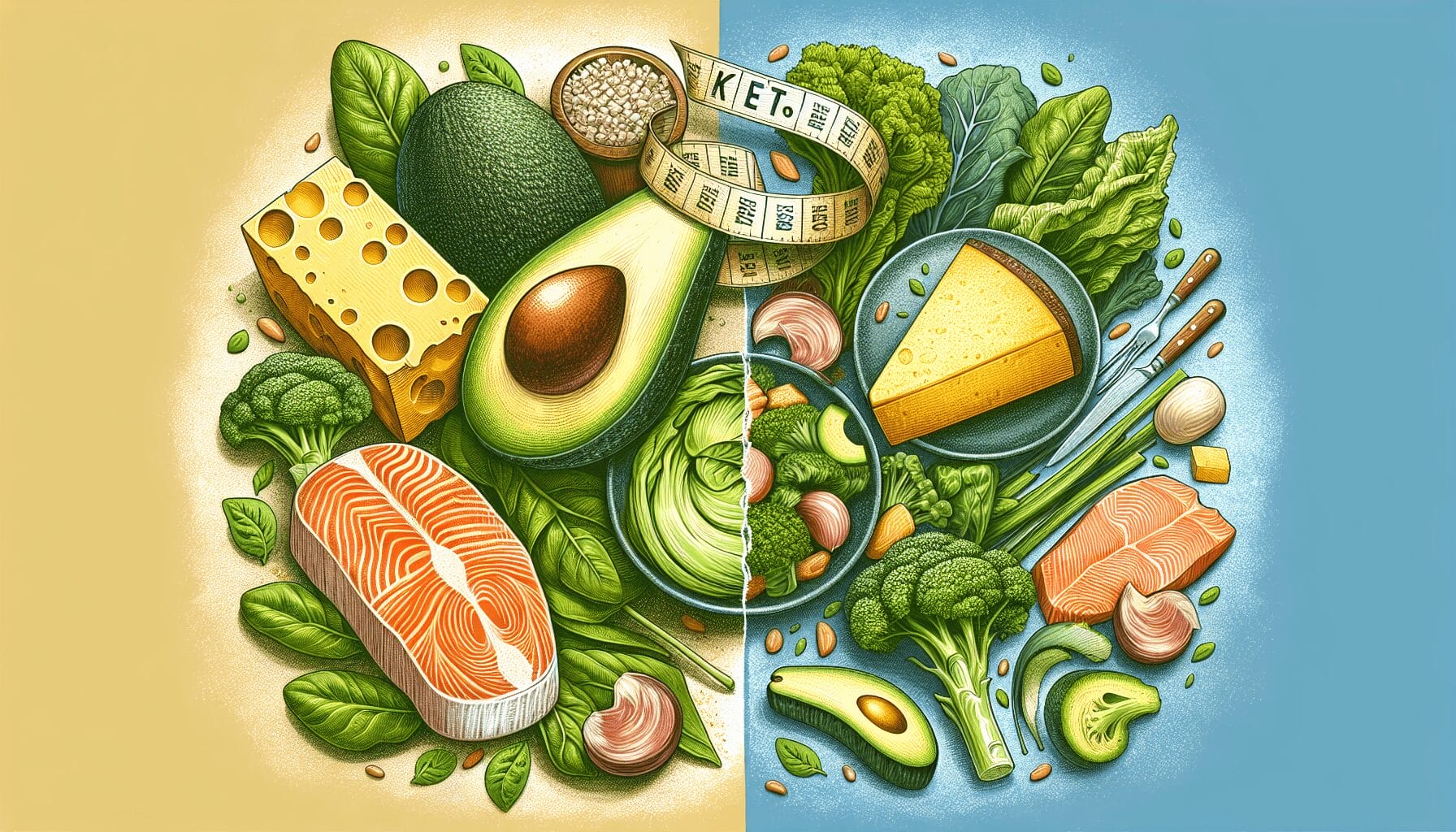Embarking on a journey to a healthier lifestyle, you might find yourself at a crossroads between choosing a keto diet or opting for a low-carb lifestyle. Both paths promise to redefine your relationship with food, yet they carry distinct differences that could sway your decision. This article sheds light on the key contrasts between a ketogenic diet and a low-carb diet, focusing on their nutritional philosophies, daily carb intake, and health impacts. By understanding these nuances, you’ll be better equipped to make an informed choice that aligns seamlessly with your wellness goals and dietary preferences.
Get your Free Keto Recipe eBook Now!
Understanding Carbohydrates
Carbohydrates play a pivotal role in your diet and overall well-being. Grasping the basics of carbohydrates can help you make informed decisions about what you eat and how it impacts your health.
Role of carbohydrates in the body
Carbohydrates are your body’s primary source of energy. They are broken down into glucose (sugar) before being absorbed into your bloodstream. From there, glucose enters your body’s cells with the help of insulin. Your body uses this glucose for energy for your cells, tissues, and organs, storing any excess glucose in your liver and muscles for when it’s needed.
Different types of carbohydrates
Carbohydrates come in three main forms: sugars, starches, and fiber. Sugars are simple carbs, found naturally in fruits, vegetables, and dairy, or added to foods and drinks. Starches are complex carbs, present in grains, legumes, and some vegetables. Fiber, also a complex carb, is in plant foods and aids digestion.
The impact of carbohydrates on blood sugar levels
Carbohydrates have a direct impact on your blood sugar levels. When you consume carbohydrates, your body breaks them down into glucose, leading to an increase in blood sugar levels. The speed and magnitude of the increase depend on the type of carbohydrate. Simple carbohydrates tend to spike blood sugar levels quickly, while complex carbohydrates, containing fiber, usually result in a slower increase.
What is a Ketogenic Diet?
A ketogenic diet significantly reduces carbohydrate intake, substituting it mostly with fat, to push your body into a state of ketosis.
Definition and origins of the ketogenic diet
The ketogenic diet is a low-carb, high-fat diet that aims to alter your body’s primary energy source from glucose to ketones, which are compounds your liver creates from stored fat. This diet has its origins in the 1920s as a treatment for epilepsy.
Key principles of the ketogenic diet
The key principle of the ketogenic diet revolves around minimizing carbohydrate intake to about 5% of your daily calories to encourage your body to switch from using glucose as its main fuel source to burning fat.
Typical macronutrient distribution
On a ketogenic diet, the typical macronutrient ratio is heavily slanted towards fats, which can make up 70-80% of your total daily caloric intake. Proteins are moderate at around 20-25%, and carbohydrates are extremely restricted, usually to below 50 grams a day.

Get your Free Keto Recipe eBook Now!
What Defines a Low-Carb Diet?
A low-carb diet, as its name suggests, limits carbohydrate intake but not as severely as a ketogenic diet.
General characteristics of low-carb diets
Low-carb diets primarily restrict the amount of carbohydrates you eat. The focus is on reducing carbs like sugars and starches and replacing them with protein and fat, though not to the same extent as the ketogenic diet.
Variations of low-carb diets
There are several versions of low-carb diets, each with varying levels of carbohydrate restriction. These include the Atkins diet, the South Beach diet, and the Paleo diet.
Typical macronutrient distribution
The macronutrient spread for a low-carb diet can vary, but generally, carbohydrates are limited to 10-20% of daily calories. Protein might increase to 40-60%, with fats making up the remainder.
Key Differences Between Keto and Low-Carb
While both diets reduce carbohydrate intake, there are significant differences in the extent and implications of these reductions.
Differences in carbohydrate intake
The most striking difference is in the amount of carbs allowed. Keto requires a very low carb intake to maintain ketosis, usually less than 50 grams per day, while low-carb diets are more flexible and less strict.
The role of ketosis in keto
A unique aspect of the keto diet is its reliance on ketosis, a metabolic state where the body burns fat for fuel instead of carbohydrates. This doesn’t happen in low-carb diets unless they also lower the carbohydrate intake sufficiently to induce ketosis.
Comparing fat intake
Fat intake is substantially higher in the keto diet to compensate for the reduced carbohydrates, which is not necessarily the case with low-carb diets that may focus more on protein.
Varieties of food choices
Due to the strict carb limit, keto often restricts more foods, including some vegetables and most fruits, than low-carb diets, which can allow for a broader selection of foods within the carbohydrate limit.

Similarities Between Keto and Low-Carb
Despite their differences, keto and low-carb diets share several common benefits.
Shared benefits on weight loss
Both diets can lead to weight loss by reducing carbs and lowering insulin levels, which can decrease appetite and lead to a spontaneous reduction in calorie intake.
Blood sugar control
Low-carb and keto diets can both improve blood sugar control, which is beneficial for preventing diabetes and managing symptoms in those already diagnosed.
Potential health benefits beyond weight loss
Beyond weight loss, both diets have been linked to other health benefits, such as improved heart health and cognitive function, though the extent and mechanisms of these benefits can vary between diets.
Health Benefits
Both diets offer distinct health advantages, with some overlap between them.
Benefits of Keto Diet
The keto diet can lead to significant improvements in blood sugar levels, weight loss, and symptoms of metabolic syndrome. It may also reduce seizures in epileptic patients.
Benefits of Low-Carb Diet
Low-carb diets can also promote weight loss and improve heart disease risk factors, such as reducing LDL (bad) cholesterol and increasing HDL (good) cholesterol levels.
Comparative analysis of health benefits
While both diets offer potential health benefits, the keto diet’s stricter enforcement of carbohydrate restriction might offer more significant benefits for blood sugar control and epilepsy, whereas low-carb diets provide a more flexible approach that may be easier to maintain long term.
Challenges and Considerations
Adopting either diet comes with its set of challenges and things to consider.
Potential risks and side effects
Both diets can lead to side effects, especially initially, such as the keto flu, constipation, or nutrient deficiencies. Long-term adherence to a strictly ketogenic diet may also pose challenges, and the impact on lipid profiles is a debated topic.
Considerations for long-term sustainability
The strict nature of the keto diet may be hard for some to maintain long term, making low-carb diets a potentially more sustainable choice for those seeking flexibility.
Diet adherence and lifestyle impact
Your lifestyle, preferences, and goals should dictate your choice of diet. Adherence is key to success, so choosing a diet that fits your life is crucial.
Impact on Athletic Performance
Both diets can impact athletic performance in different ways.
Effects of Keto on endurance and strength
Adapting to the keto diet can initially impair performance, especially where high intensity or quick energy is required. Over time, some adapt and may see improvements in endurance, though results can vary.
Effects of low-carb diets on sports performance
Low-carb diets might be less restrictive and therefore less likely to impact performance negatively, but the reduction in readily available glucose could still affect high-intensity activities.
Optimizing performance on either diet
Adaptation and personalization are key. Understanding and listening to your body can help optimize performance, and adjustments to carb intake before intense activities can be beneficial.
Choosing the Right Diet for You
Finding the right diet depends on your personal health goals, conditions, and lifestyle.
Assessing individual health goals
Consider what you aim to achieve – weight loss, improved health markers, or better control of a health condition – and choose accordingly.
Considerations based on medical conditions
Discuss with a healthcare provider, especially if you have conditions like diabetes, as diet changes can affect medication needs.
Lifestyle factors influencing diet choice
Consider your ability to adhere to diet restrictions, cooking preferences, and social and exercise habits to find the diet that you can sustain long term.
Conclusion
Both the ketogenic and low-carb diets offer avenues for weight loss, health improvement, and potential lifestyle changes. Yet, they come with their unique sets of rules, benefits, and challenges. Whether you choose keto for its stringent carb limits and potential for ketosis or opt for the more flexible low-carb approach, the best diet is the one that aligns with your individual health goals, lifestyle, and one that you can adhere to. Remember, there’s no one-size-fits-all approach to dieting, and exploring personal testimonies and success stories can offer additional insight and encouragement. Your journey to health and wellness is uniquely yours, and exploring these dietary paths can be a significant step in finding what works best for you.

